25 Insights into the Great Barrier Reef's Importance
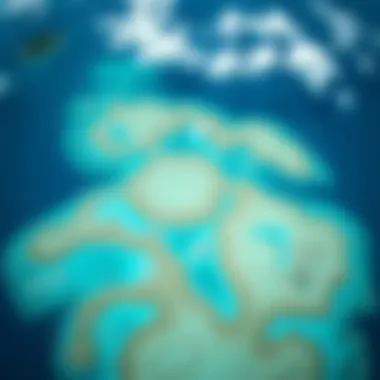
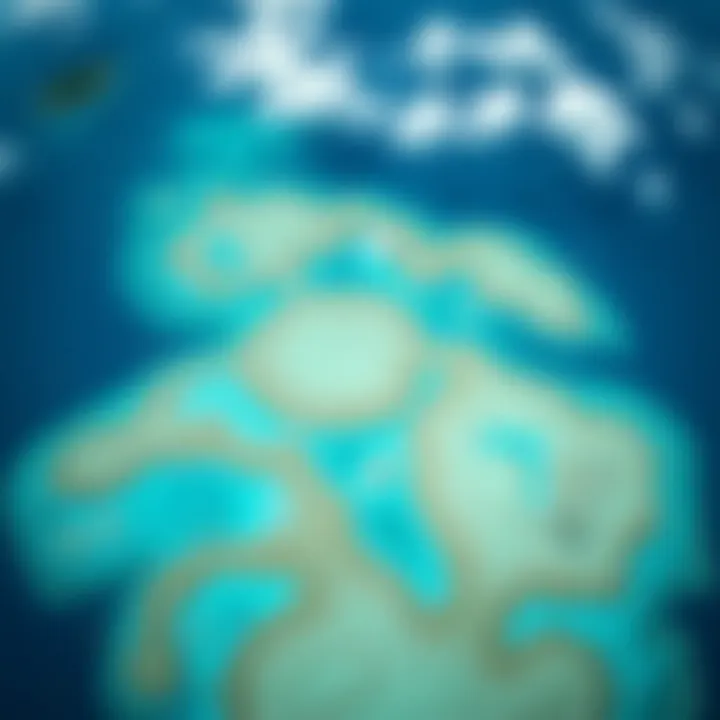
Intro
The Great Barrier Reef, stretching over 2,300 kilometers along the northeast coast of Australia, stands as a monumental testament to nature's wonder. This intricate tapestry of coral formations, teeming with vibrant marine life, captures the imagination of divers, snorkelers, and marine enthusiasts alike. But beyond its picturesque allure lies a complex ecosystem that plays a crucial role in the global environment.
This article sets out to uncover 25 insightful facts about this natural marvel, diving into its rich biodiversity, ecological importance, and the challenges it faces. For those with a passion for watersports or simply an appreciation for nature's splendor, there is much to learn. Discovering the breadth of life that thrives beneath the waves not only fosters a deeper understanding but also highlights the urgent need for conservation efforts.
As we navigate through facts and lesser-known tidbits, prepare to unravel the intricacies of the Great Barrier Reef and why preserving it is vital for not only the marine inhabitants but for the health of our own planet.
From highlighting essential tips for beginners diving into watersports, to the advanced techniques for experienced adventurers, this guide aims to provide a thorough exploration for athletes, coaches, and nature lovers. So, whether you are pondering your first snorkeling experience or looking to refine your skills in the water, this insight-rich discussion will equip you with knowledge that extends beyond the surface.
Understanding the Great Barrier Reef
The Great Barrier Reef is not just a stretch of coral; it’s a living tapestry of life that plays a crucial role in our planet's marine ecosystem. Understanding its intricacies comes with benefits that extend beyond the borders of Australia. This knowledge can significantly influence conservation efforts, responsible tourism practices, and overall respect for natural wonders.
Through learning about this iconic reef, individuals, from athletes engaging in water sports to educators unraveling ecological mysteries, can advocate for its preservation. The Great Barrier Reef, a UNESCO World Heritage site, is both a natural wonder and a vital ecosystem. Its health reflects the health of our oceans, making it a barometer for environmental stability. Exploring this topic deeply can open the eyes to why protecting this marvelous expanse is not solely an Australian concern but an international imperative.
Geographical Significance
The Great Barrier Reef stretches over 2,300 kilometers along Queensland's coast, making it the largest coral reef system on the planet. Geographically, it forms an immense barrier that protects coastlines from erosion and storm surges.
- Biodiversity Hotspot: It houses nearly 1,500 species of fish, over 400 types of coral, and numerous species of mollusks and sea turtles.
- Ecotone: It serves as a critical transition zone between marine and terrestrial ecosystems. The reef directly affects the adjacent marine environment, creating a rich habitat that supports diverse organisms.
Its shape is not merely a geological accident; the reef's configuration creates varied habitats that are essential for different species. The Whitsunday Islands, for instance, provide sheltered waters perfect for nurturing juvenile fish, while the Outer Reef areas provide strong currents that sustain larger predator species.
Understanding this geographical significance helps one appreciate how interlinked ecosystems are, and why alterations in one part can have rippling effects elsewhere.
Historical Formation
The history of the Great Barrier Reef is as layered as the corals that compose it. It began forming over 25 million years ago, primarily made up of calcium carbonate produced by coral polyps. Its ongoing creation and erosion are influenced by factors like sea levels and climate changes throughout history.
- Evolving Ecosystem: The reef’s structure has undergone distinct periods of growth and decline, often aligned with changing sea levels during ice ages. For example, during glacial periods, the reef was exposed, leading to substantial mortality of coral species. Upon the melting of the glaciers, the sea levels rose, leading to the current configuration we see today.
- Indigenous Awareness: The history of the reef is also deeply tied to the Indigenous Australian stories and knowledge systems that have existed for thousands of years. They viewed the reef not just as a resource, but as part of their spiritual and cultural identity, leading to sustainable practices that are remarkably relevant today.
The historical formation of the Great Barrier Reef is not just a tale of geological processes but a narrative interwoven with the cultural fabric of the local communities. It sheds light on the reciprocal relationship between nature and humanity, evoking a sense of responsibility for its future.
"The Great Barrier Reef stands as a witness to history, both natural and cultural, reminding us of the deep connections we share with our environment."
With this understanding, one can begin to grasp the unique importance of the Great Barrier Reef, making it clear that protecting it is an endeavor requiring a collective commitment.
Biodiversity within the Reef
Biodiversity is the lifeblood of the Great Barrier Reef, playing an irreplaceable role in its overall health and vitality. The sheer variety of life forms—spanning from the tiniest plankton to massive whales—creates complex interactions that help maintain ecological balance. This section dives into the myriad of coral species, the thriving marine fauna, and the unique ecosystems that make this marvel so significant. Understanding these components is essential as they not only contribute to the reef’s resilience but also its ability to provide for countless species and humans alike.
Coral Species
Coral species are often referred to as the architects of the reef, as they serve as the foundational building blocks of this underwater metropolis. There are over 400 distinct types of coral found in the Great Barrier Reef, each one adding its own flavor to the ecological stew. What’s fascinating is how these species come in all shapes and colors, from the branching Staghorn coral, which provides shelter for juvenile fish, to the massive Brain coral that forms an impressive landscape beneath the waves.
Coral species can broadly be classified into two types: hard corals and soft corals. Hard corals, like the Acropora and Porites genera, form the coral reefs that provide habitats for numerous marine organisms, while soft corals, such as sea fans and gorgonians, add aesthetic allure but don't contribute to reef structure in the same way.
"Healthy coral reefs are akin to bustling cities, fostering biodiversity and sustaining life in a way that's simply breathtaking."
Preservation is crucial as these coral species are sensitive to changes in water temperature and quality. Signs of stress, such as bleaching, can reverberate through the entire ecosystem.
Marine Fauna
The Great Barrier Reef is a smorgasbord of marine life—think of it as nature's own rich and varied buffet. Among its inhabitants are around 1,500 species of fish, 4,000 species of mollusks, and over 1,500 species of sponges. Notable species include the clownfish, which has an iconic relationship with sea anemones, and the elusive manta ray, which glides gracefully through the water, captivating onlookers.
This marine fauna plays a significant role in maintaining the health of the reef. The grazing habits of certain fish species help control algae growth, ensuring that coral remains unhindered and healthy.
Additionally, larger creatures like sea turtles and sharks serve key ecological functions. The shark, often perceived as a villain, actually helps keep other fish populations balanced, thereby maintaining the delicate equilibrium essential for the reef’s survival.
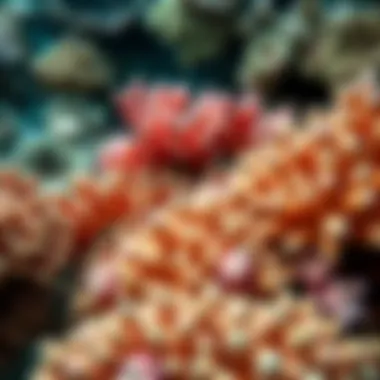
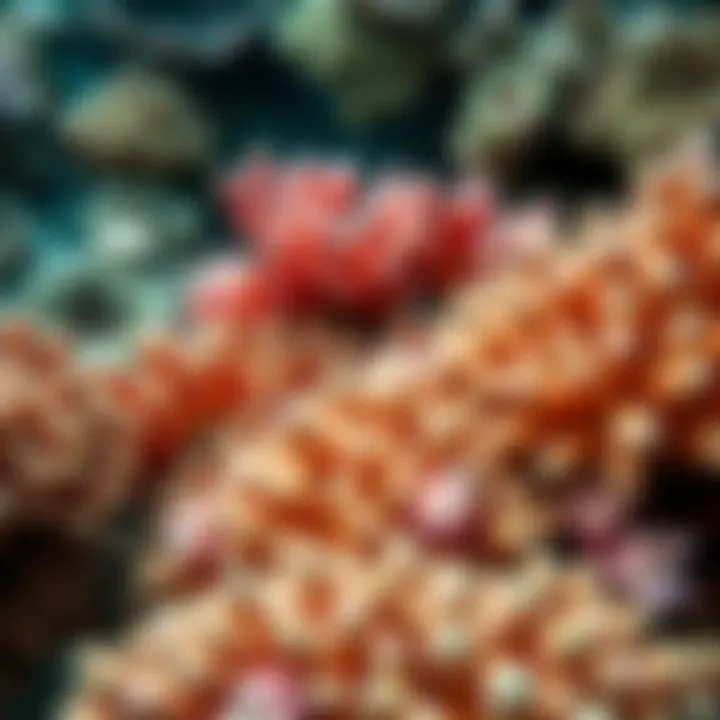
Unique Ecosystems
The Great Barrier Reef is not just a singular entity; it is a web of unique ecosystems that each contribute to its health and diversity. From shallow lagoons to deep-sea habitats, these ecosystems foster distinct forms of life that are interconnected. For example, mangroves and seagrasses serve as essential nurseries for many fish species, providing protection during their vulnerable stages.
Moreover, the intertidal zones along the reef offer a distinct habitat for organisms like crabs and mollusks, which thrive in the changing tides. Coastal wetlands and estuaries further enrich this biodiversity, acting as transition zones where riverine and marine life interact.
Engagement in these unique ecosystems varies greatly; some areas may be bustling with colorful life while others are serene and atmospheric. Each environment plays a critical role in the larger system—something we often overlook amid the spectacle of bright coral and gracefully swimming fish.
Cultural Importance
The Great Barrier Reef is not only a natural marvel; it holds deep cultural significance for many communities, particularly the Indigenous peoples of Australia. The relationship that these groups have with the reef, imbued with rich traditions and spirituality, highlights the importance of preserving this unique ecosystem. Their historical knowledge about sustainable practices and species conservation offers invaluable insights that clash with prevalent modern attitudes toward marine resource use.
Indigenous Knowledge
For thousands of years, the Indigenous communities, such as the Torres Strait Islander people, have cultivated an intricate understanding of the Great Barrier Reef's ecosystems. They view the reef not merely as a collection of resources but as a living entity, a mentor of sorts that teaches respect for the environment.
This connection goes beyond everyday practices; it is woven into storytelling, ceremonies, and the arts. The songs and dances reflect the reef's rhythms, illustrating seasons and marine life cycles. Indigenous knowledge systems prioritize harmonious living with nature, involving practices that have allowed them to manage resources sustainably for generations. Their wisdom can guide current conservation efforts and promote a sense of reverence for the environment that is often missing in contemporary dialogue.
To put it in perspective, the use of 'sea country' is a term among Indigenous Australians that signifies a holistic approach to their relationship with marine environments. As a result, efforts to include Indigenous voices in policymaking around conservation can yield more effective outcomes.
Tourism and Economic Dependence
The Great Barrier Reef attracts millions of tourists each year, making tourism one of the linchpins of the local economy. Although this influx brings numerous jobs and opportunities, it also poses significant challenges concerning environmental sustainability. Tourists want to explore the waters, dive into the vibrant corals, and experience marine life. However, the question arises: how do we strike a balance?
Tourism can drive economic growth, but it can also lead to overcrowding and degradation of sensitive areas within the reef. Some benefits of tourism include:
- Job creation: From tour guides to marine biologists, people rely on the reef for their livelihoods.
- Funding for conservation: Entrance fees and tourist taxes can be funneled back into preservation projects.
- Cultural exchange: Visitors learn about the Indigenous perspectives and contribute to a broader conversation about conservation.
The notion of responsible tourism is emerging, with more organizations advocating for eco-friendly practices. Tour companies are also adapting, offering guided tours that respect local culture and promote awareness about the reef's fragility. To spearhead these shifts, there are calls for leveraging technology in tourism to minimize human impact on delicate reef ecosystems.
Environmental Challenges
The Great Barrier Reef is not just a stunning locale; it's a tapestry of intricate ecosystems facing myriad challenges. Environmental concerns, such as climate change, pollution, and overfishing, pose significant threats to the reef's health and longevity. Understanding these challenges is crucial for stakeholders: from environmentalists to travelers and local communities who rely on the reef for their livelihoods.
Climate Change Impact
Climate change has emerged as a major adversary for the Great Barrier Reef. The rising sea temperatures and acidification of the oceans are altering the very fabric of this natural wonder.
Rising Temperatures
Rising temperatures in the oceans lead to coral bleaching, a phenomenon where corals expel the colorful algae that provide them with energy. As a result, the reef's vibrant hues fade into a stark, ghostly white.
- Implication: This is not just an aesthetic loss. Coral reefs are vital habitats for myriad marine species and their decline can lead to substantial biodiversity loss.
- Significance: Coral bleaching events have seen increasing frequency over the past few decades, primarily due to climate-related stressors.
- Consideration: One unique feature of rising temperatures is its cascading effect on marine ecosystems. If water temperatures remain elevated, the likelihood of longer-lasting coral bleaching increases. This can disrupt food webs and affect fish populations that depend on healthy reefs.
Ocean Acidification
Ocean acidification is another challenge exacerbated by climate change, primarily due to increased CO2 absorption by ocean waters. This chemical change affects coral growth and skeleton formation, weakening their structures and making them more susceptible to other stressors.
- Implication: The reduction in calcium carbonate availability can hinder coral reefs' ability to grow and maintain their habitats.
- Significance: Ocean acidification has gained attention as a significant concern, as its effects on coral and shellfish populations can ripple through the entire marine food chain.
- Consideration: Its unique feature lies in how it directly affects aragonite saturation levels, an essential factor for coral reef calcification. If these levels drop too low, the survival of coral species may be at severe risk, pushing them closer to extinction.
Pollution Effects
Pollution is an insidious threat that compromises the Great Barrier Reef's resilience and biodiversity. Runoff contaminants and plastic waste are two of the most severe pollutants impacting the reef's ecosystems.
Runoff Contaminants
Runoff contaminants, often from agricultural activities, introduce harmful substances into the ocean. Nutrient runoff, particularly nitrogen and phosphorus, can lead to algal blooms that suffocate corals and consume oxygen in the water.
- Implication: This nutrient overload disrupts the delicate balance of marine ecosystems and can lead to fish die-offs.
- Significance: Addressing runoff contaminants is vital in maintaining the health of the reef, as they are often a direct result of human activities.
- Consideration: A unique feature of runoff contaminants is their long-lasting effects on water quality. Once pollutants enter the marine environment, reversing their impact can take substantial effort and time.
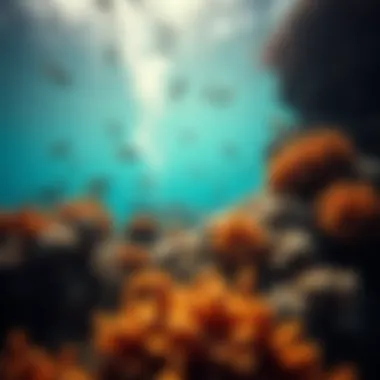
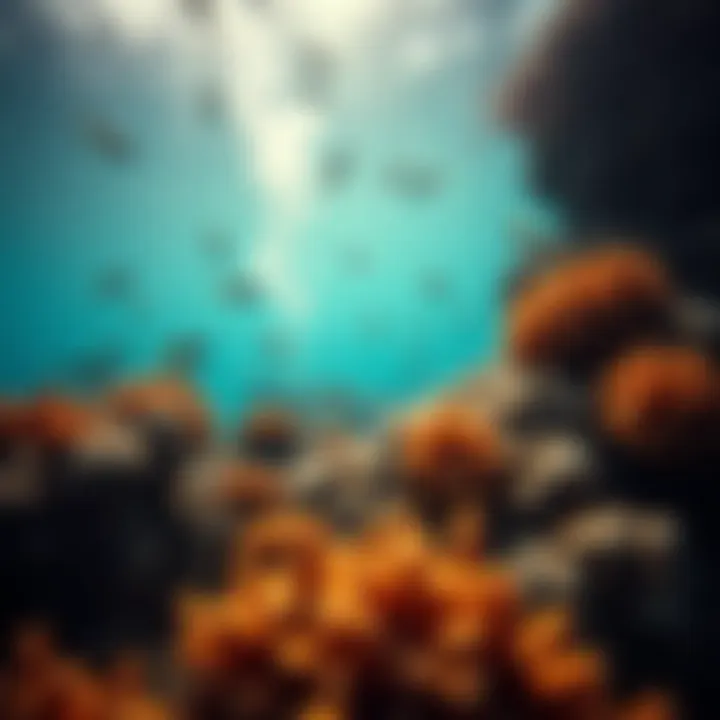
Plastic Waste
Plastic waste is perhaps the most visible pollutant, with its detrimental impact manifesting as unsightly debris floating in the water and entangling marine life. Smaller pieces, known as microplastics, have infiltrated even the most remote corners of the marine ecosystem.
- Implication: Marine animals often mistake plastic for food, leading to detrimental health effects, including starvation and behavioral changes.
- Significance: The ubiquity of plastic waste has made it a growing concern globally. The damage it causes to the reef often goes unnoticed until observable marine life starts declining.
- Consideration: A unique characteristic of plastic waste is its permanence. While Nature has the ability to break down organic materials, plastics can take hundreds of years to decompose, exacerbating their negative impact on the environment.
Overfishing Consequences
Overfishing can seem an abstract concern, but its consequences are palpable. The depletion of key fish species destabilizes the marine ecosystem and alters the food web. The repercussions extend far beyond the immediate removal of fish; it can result in ecosystem shifts that can take years to recover from.
- Intensive fishing practices threaten not just targeted species but also bycatch, affecting vulnerable populations of fish and other marine organisms.
- The decline in fish populations can lead to increased algal growth, as herbivorous fish, which keep algae in check, are removed. This creates imbalances affecting coral growth and ecosystem health.
Understanding the environmental challenges facing the Great Barrier Reef is critical to its survival. Each element, from rising temperatures to pollution, contributes to an intricate web of interdependencies, making it clear that urgent action is necessary to protect this extraordinary ecosystem for future generations.
Conservation Efforts
Conservation efforts are the lifeblood of sustaining the Great Barrier Reef. This incredible ecosystem is under constant threat from various factors such as climate change, pollution, and overfishing. Conservation signifies not just protecting the reef but nurturing it, allowing it to flourish for generations to come. The collective action of communities, organizations, and governments plays an essential role in these efforts, aiming for a balance between human activities and ecological integrity.
Protective Legislation
Legislation acts as a crucial framework for safeguarding the Great Barrier Reef. In Australia, the Environment Protection and Biodiversity Conservation Act 1999 provides legal backing to conserve biodiversity across the reef. This law helps regulate activities that could harm the reef, creating a structured approach to manage human interaction with this delicate environment. Other laws, like the Great Barrier Reef Marine Park Act 1975, specifically target the management of the marine park, ensuring sustainable tourism practices and fishing regulations are followed.
Such protective measures can help enhance the resilience of coral structures against the impacts of climate change and pollution. They serve as a reminder that while humans may influence their surroundings, it's our responsibility to tread lightly, keeping the reef's integrity intact.
"The Great Barrier Reef is a delicate balance of life; preserving it is akin to maintaining a symbiotic relationship."
Community Initiatives
Grassroots movements often root the conservation image of the Great Barrier Reef. Local communities are the front-line defenders, taking initiatives to protect their marine environment. One shining example is the Reef Guardians Program, where local schools, families, and businesses work together to promote sustainable practices such as coastal clean-ups and educational outreach about responsible tourism.
Additionally, initiatives like the CoralWatch project empower individuals to monitor the health of the reefs, contributing valuable observations and fostering a sense of ownership among community members. The more aware people become about the reef’s significance, the more likely they are to invoke support and action. Engaging locals and encouraging them to participate in conservation enriches not just the community, but the environment it seeks to protect.
Scientific Research
Scientific research holds the key to unlocking the capable aspects of conservation efforts. Universities and researchers conduct ongoing studies to achieve a greater understanding of reef dynamics, biodiversity assessments, and climate change impact analysis. Institutions such as James Cook University engage in extensive ecological research and draw parallels to other marine ecosystems globally, enhancing our understanding.
One significant ongoing initiative involves studying coral resilience against climate changes, aiming to find ways to assist coral recovery. Innovative approaches, like selective breeding of heat-resistant coral and advancements in aquaculture, offer hope for developing more robust coral varieties. Moreover, this research guides policymakers in making informed decisions that benefit both the reef and the surrounding communities.
Useful Resources
- Great Barrier Reef Marine Park Authority
- Australian Government Department of Agriculture, Water and the Environment
- James Cook University
The Human Connection
The relationship between humanity and the Great Barrier Reef is a tapestry woven over centuries. This connection not only reflects the reef's ecological wonder, but also the cultural and economic threads that bind local communities to this natural marvel. Understanding this relationship is crucial for appreciating the broader implications of conservation and tourism.
Recreational Activities
Diving and Snorkeling
Diving and snorkling are among the most intimate ways to connect with the Great Barrier Reef. They provide an immersive experience, allowing individuals to witness the vibrant marine life and intricate coral structures up close.
The unique aspect of diving here is its accessibility; you don't need to be a pro to enjoy the sights. Many companies offer guided tours that cater to various skill levels, ensuring that everyone can explore this underwater paradise. However, the sheer beauty of the reef can also lead to environmental concerns. Overcrowding and inexperienced divers can inadvertently cause damage, a fact that leaves conservationists in a bit of a bind.
Pros:
- Close encounters with marine biodiversity.
- Educational experiences about reef conservation.
- Well-established tour services that prioritize safety.
Cons:
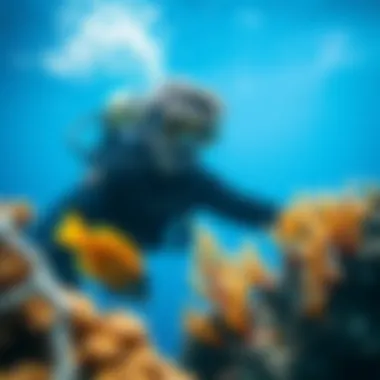
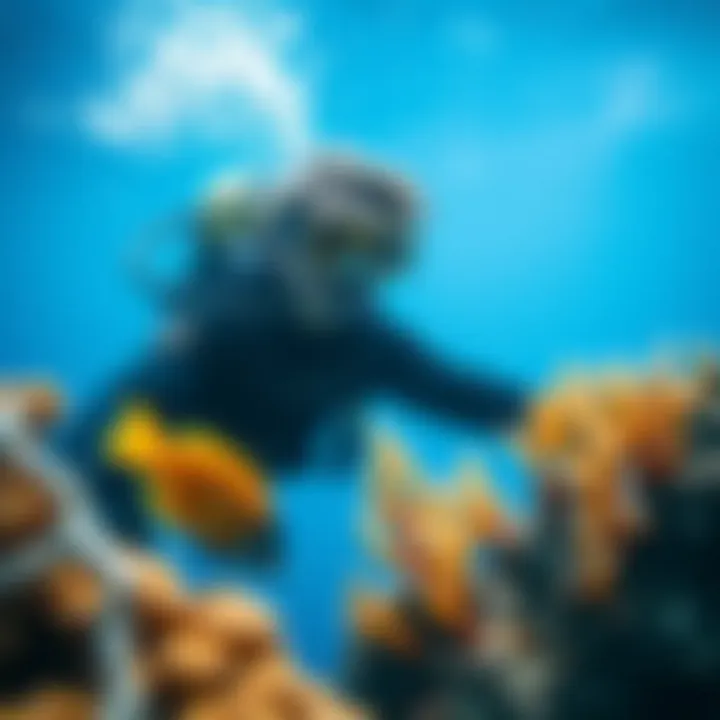
- Risk of coral damage from careless behavior.
- Potential for increased pollution from more visitors.
Kayaking
Kayaking offers another unique perspective on the reef, enabling participants to glide through the crystal-clear waters at their own pace. This activity is particularly appealing because it allows for a quieter exploration, often leading to encounters with marine life that skittish divers might miss.
The beauty of kayaking lies in its accessibility; it requires minimal training compared to diving. Many users appreciate the tranquil experience away from bustling tourist areas. However, paddlers need to be aware of tidal changes and marine wildlife, ensuring they navigate responsibly.
Pros:
- Opportunity for solitude and peaceful exploration.
- Low-impact activity that respects the fragile ecosystem.
- Flexible timings allow for spontaneous adventures.
Cons:
- Vulnerability to changing weather conditions.
- Limited underwater viewing compared to diving.
Responsible Tourism
Responsible tourism becomes increasingly vital as visitor numbers rise. It underscores the need for every individual to engage with the environment in a manner that acknowledges its value and fragility.
By promoting environmentally-friendly practices, such as adherence to specific guidelines during water-based activities, tourists can help maintain the integrity of the reef. Whether it's advocating for "Leave No Trace" principles or partaking in local clean-up initiatives, each effort counts.
Quote:
"Tourism can be a double-edged sword; we must choose wisely to preserve the very beauty we seek to explore."
Future of the Great Barrier Reef
The future of the Great Barrier Reef is a conversation that carries immense weight. As one of the planet's most critical ecosystems, its health directly influences marine biodiversity and environmental stability. The reef itself is not just a stunning visual spectacle; it's a complex network of life that nurtures a multitude of species. Understanding its future involves a deep dive into what factors are at play, the potential changes on the horizon, and the ongoing efforts to monitor and support its health.
Predicted Changes
Predictions regarding the Great Barrier Reef are far from rosy. Studies indicate that climate change will bring about profound transformations. Temperature increases pose the most immediate threat. The scientific community warns that if ocean temperatures rise just 1.5 degrees Celsius above pre-industrial levels, coral bleaching events will become commonplace.
- Coral Bleaching: An inevitable consequence of rising sea temperatures, this occurs when stressed corals expel the symbiotic algae they rely on for food. The result is a stark, white reef that can lead to coral death if the stress isn't alleviated.
- Shifts in Marine Life: As temperatures rise and acidification increases, marine species' habitats will shift. Some species may thrive in new waters, while others, unable to adapt, face decline or extinction.
“If we don’t act now, the biodiversity we take for granted may become a mere memory.”
The impact of ocean acidification should not be overlooked either. As CO2 levels in the atmosphere rise, more of it dissolves into oceans, leading to lower pH levels. This can severely affect coral growth and other organisms that rely on calcium carbonate for their structure, such as mollusks and certain fish.
Additionally, overfishing and pollution remain pressing issues. As human activities continue to proliferate along the Australian coast, the combined effects of heavy boating traffic, land runoff, and waste disposal exacerbate the reef's challenges.
Ongoing Research and Monitoring
To counteract the concerning trends, a significant emphasis is placed on ongoing research and monitoring of the reef. Various initiatives are underway that strive to collect data crucial for understanding the reef’s health and anticipating its future. Researchers are leveraging technology in innovative ways to track changes over time.
- Drone Technology: Equipped with cameras and sensors, drones are increasingly being deployed to monitor large sections of the reef. They can efficiently gather data on coral health, fish populations, and water quality without disturbing marine life.
- Underwater Sensors: Advanced sensors are being utilized to monitor temperature, salinity, and pH levels in real-time. These devices provide critical data that informs decision-makers regarding conservation strategies and immediate responses to environmental changes.
- Citizen Science Programs: Engaging local communities plays a vital role. Programs that encourage residents and tourists to assist in monitoring efforts foster a sense of stewardship and heighten awareness of the challenges facing the reef.
The collaboration between government, scientists, and the community is key. Local fishing regulations are being adjusted based on research findings, and educational programs aim to instill deeper knowledge about the reef’s ecological significance among both residents and visitors. This collaborative approach is essential for ensuring that the Great Barrier Reef navigates through these unpredictable waters to secure its future.
Final Thoughts on Conservation and Awareness
The Great Barrier Reef is not just a marvel of nature; it serves as a crucial component of our planet's marine ecosystem. It is essential to understand the significance of the reef in the context of global biodiversity, climate resilience, and human well-being. To put it simply, the health of the reef reflects the health of our oceans and, ultimately, the health of our planet. The alarming deterioration of this natural wonder due to climate change, pollution, and overfishing urges a collective call for action and assessment of our role within this intricate web of life.
Understanding conservation and awareness in relation to the Great Barrier Reef requires a multi-faceted approach. This involves individuals, communities, and organizations working hand-in-hand to foster sustainable practices and promote awareness of the issues at stake. From environmental education to participation in local conservation programs, every action counts.
Moreover, recognizing the interdependency of human life and the reef ecosystem underlines the importance of awareness-building strategies. When people grasp the intrinsic value of such ecosystems, they are more likely to take steps to protect them. This leads to not just individual but collective efforts aimed at ensuring the survival of this iconic habitat.
"If we take care of the reef, it will take care of us. It is the circle of life that needs protecting."
Individual Action Steps
- Educate Yourself and Others: Knowledge is power. Share the information you gain about the Great Barrier Reef with friends and family. The more people know about its vulnerabilities, the likelier they are to advocate for its protection. Consider using resources like Wikipedia or Britannica to broaden your understanding.
- Participate in Local Conservation Programs: Get involved with NGOs or community initiatives that focus on marine conservation. Whether it’s beach clean-ups or coral planting projects, these activities will help enrich your connection to the reef and contribute to its vitality.
- Practice Responsible Tourism: If you’re planning a visit to the Great Barrier Reef, make choices that minimize your environmental footprint. Opt for eco-friendly tours, avoid touching corals, and be mindful of pollution creation during your visit.
- Advocate for Policy Changes: Support policies that aim to protect marine environments; write to your local representatives or join advocacy groups that focus on marine and environmental issues. Awareness can be taken further when it translates into action at the policy level.
- Reduce Plastic Usage: Simple acts like bringing reusable bags and water bottles can drastically lower the amount of plastic waste entering oceans, which is detrimental to marine life. It’s a small step, but if replicated widely, it can lead to significant change.
- Stay Informed on Environmental Issues: Keep abreast of the challenges the Great Barrier Reef faces. Websites like National Oceanic and Atmospheric Administration (NOAA) and various educational institutions provide insights into ongoing research and findings.
Committing to these individual actions can create ripple effects, furthering the movement for the conservation of the Great Barrier Reef. Protecting this ecosystem is not merely the responsibility of scientists or government bodies; it’s a shared duty that every individual has to take seriously.















